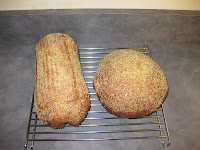Baying Hound Aleworks
Rockville, MD
In the seventh installment of our Nanobrewery Interviews, we spoke with Paul Rinehart, the founder of Baying Hound Aleworks, located in Rockville, Maryland. Paul is a trained professional chef who comes from a line of chemists, brewers, and bootleggers. He began brewing at a young age and has continued homebrewing to this day. Paul's interest in beer, along with his chef training, has pushed Baying Hound Aleworks's beers towards pairing well with food. In fact, Paul offers recommended beer and food pairings, along with a number of recipes on his website.
The Baying Hound Aleworks began operation in Rockville in July 2010, though it only officially opened for business earlier this month. Paul uses a 55-gallon brew house and two 42 gallon fermenters. He bottles the beer and offers it for sale within Montgomery County, MD, though he hopes to eventually distribute in the District of Columbia and Virginia. The brewery is named in honor of Marmalade, Paul's late bloodhound companion, who used to enjoy left-over spent grain from his basement homebrewery.
Below is our interview with Paul.
* * *
Lug Wrench (LW): What inspired you to start-up a nanobrewery?
Paul Rinehart (PR): I always wanted to open a brewery, starting a nanobrewery seemed to be the next logical step in the evolution of a homebrewer. The only thing that sets me apart from a homebrewer is that I can legally sell my beer.
LW: How did you gather the required capital to start the nanobrewery?
PR: I took out a loan and got financial backing from my family and some of my savings.
LW: How have you involved the community in your brewery? Do you interact with local homebrew clubs?
PR: Since I started my nanobrewery, which is actually the only manufacturing/wholesale brewery in Montgomery County, I have had a lot of homebrewers asking me what it would take to start their own. I took part in a beer festival back in October, and will be doing a few other festivals soon. I am responsible for some beer festival organizing so I've been given the job to try and contact other local brewers. I love networking and this is a great way to do it. The only interaction I have with a local brew club is being invited to a cask ale tasting put on by the Brewers United for Real Potables (BURP) homebrewing club. I hope to have a little more involvement with them in the future.
LW: With regards to selling your beer, what has been the biggest challenge you have faced in getting draft accounts or shelf space?
PR: In Montgomery County, I went to places that specialized in craft brews and not the mass produced beers, not naming any names. As for the rest of the DC metropolitan area, that is pretty much up to my distributor. The biggest challenge is getting your foot in the door, but once you are in, you're in.
LW: Looking forward, what are the biggest hurdles you see your brewery facing?
PR: Keeping up with demand. I currently produce two barrels per week, that's about 30 cases. Last week I sold 40 cases. But that's the beauty of a nanobrewery, because of its small size, its easier to upgrade.
* * *
The conclusion of our interview with Paul Rinehart and Baying Hound Aleworks will be posted shortly.
If you want to find out more about Baying Hound Aleworks, check out their website, read an article about them in the Washington Post, or stop by the brewery and buy some of their beer.
Cheers,
TW









